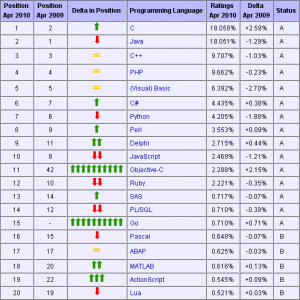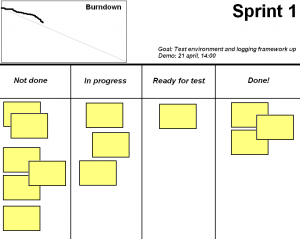According to Tiobe Programming Community Index as of April 2010, Java is no longer the most popular programming language. C is; Not due to a sudden increase in popularity of C, but rather a cause of Java’s ongoing decline.
After more than 4 years C is back at position number 1 in the TIOBE index. The scores for C have been pretty constant through the years, varying between the 15% and 20% market share for almost 10 years. So the main reason for C’s number 1 position is not C’s uprise, but the decline of its competitor Java. Java has a long-term downward trend. It is losing ground to other languages running on the JVM. An example of such a language is JavaFX script that is now approaching the top 20.
It’s important to point out, thought, that only the language part of Java is losing ground. As Tiobe Software indicates in their comment, the JVM is as hot as ever with all kinds of cool language evolution occurring.
Another interesting note to make about the april index is that Delphi is once again among the top ten. I’m really happy about that, although it means my old prophecy of a hasty decline kind of puts me in the corner (although I’ve already taken it back).
A third point is the giant leap of Objective-C, from 42:nd to 11:th most popular language. This is a combination of iPhone’s popularity and the fact that Objective-C is the only OO alternative allowed on that platform, besides C++.

Cheers!
As a project manager, the best tool I’ve come across to help me monitor and control an iteration is The Sprint Task Board. It strikes a perfect balance between expressiveness and visual feedback. One quick look is all you need to make a diagnose of the ongoing iteration. Yet, it contains most of the information needed to make informed decisions.

The task board is absolutely invaluable and I’ll probably never do team related work without it again. The question, though, is whether to use a computerized or a real world one.
Henrik Kniberg recommends the latter. The following quote is from Henrik’s excellent book Scrum and XP from the Trenches.
We’ve experimented with different formats for the sprint backlog,
including Jira, Excel, and a physical taskboard on the wall. In the
beginning we used Excel mostly, there are many publicly available Excel
templates for sprint backlogs, including auto generated burn-down charts
and stuff like that. […]
Instead […] what we have found to be the most
effective format for the sprint backlog [is] a wall-based taskboard!
And there are good reasons for picking an analog task board. Maybe the most significant being:
- Visibility. A wall-based dashboard is always up, always visible. If positioned near the team it’ll work as a constant reminder of the shape of the iteration.
- Simplicity. Planning and re-planning is simply a matter of moving physical cards around, tearing them up or writing new ones.
In my current project we’re using an application (Scrum Dashboard on top of TFS). The reasons are:
- Availability. Actually, this is the only reason for us to use a digitalized task board. We’re having dislocated team members from time to time (did I say we’re ScrumButs?) but since our dashboard is a web application they are able to access it remotely. It would be a lot more painful to relay the information otherwise.
- Automatic burndown update. No need for me (or any one else) to do a work remaining summary and update the burndown chart each and every day.
What are your reasons? I’d be most interested in hearing your point of view on this subject.
Cheers!

